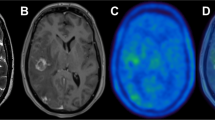Abstract
Purpose
The aim of this pilot study was to evaluate the accuracy of 18 fluorodeoxyglucose (FDG) PET/MR imaging in detection and staging of recurrent or metastatic NPC.
Patients and methods
The PET/MR scans of 60 patients with clinically diagnosed recurrent or metastatic NPC between April 2017 and November 2019 were included in this study. Findings were evaluated according to the eighth edition of the American Joint Committee on Cancer staging system. Final diagnosis was confirmed at biopsy or imaging follow-up for at least 6 months.
Results
Of the 60 patients, 25, 26 and 42 had developed local lesions, regional nodal metastases and distant metastases, respectively. The overall accuracy of PET/MR imaging for staging of recurrent or metastatic NPC was 88.3%.
Conclusions
For recurrent or metastatic NPC, 18 FDG PET/MRI might serve as a single-step staging modality.




Similar content being viewed by others
References
Chen YP, Chan ATC, Le QT, Blanchard P, Sun Y, Ma J (2019) Nasopharyngeal carcinoma. Lancet 394(10192):64–80. https://doi.org/10.1016/S0140-6736(19)30956-0
Le QT, Colevas AD, O’Sullivan B, Lee AWM, Lee N, Ma B et al (2019) Current treatment landscape of nasopharyngeal carcinoma and potential trials evaluating the value of immunotherapy. J Natl Cancer Inst 111(7):655–663. https://doi.org/10.1093/jnci/djz044
Cao CN, Luo JW, Gao L, Yi JL, Huang XD, Wang K et al (2015) Update report of T4 classification nasopharyngeal carcinoma after intensity-modulated radiotherapy: an analysis of survival and treatment toxicities. Oral Oncol 51(2):190–194. https://doi.org/10.1016/j.oraloncology.2014.11.009
Lee AWM, Ng WT, Chan JYW, Corry J, Mäkitie A, Mendenhall WM et al (2019) Management of locally recurrent nasopharyngeal carcinoma. Cancer Treat Rev 79:101890. https://doi.org/10.1016/j.ctrv.2019.101890
NCCN Guidelines Version 1.2020. http://www.nccn.org/. Accessed 24 April 2020
Chan SC, Yeh CH, Yen TC, Ng SH, Chang JT, Lin CY et al (2018) Clinical utility of simultaneous whole-body 18 F-FDG PET/MRI as a single-step imaging modality in the staging of primary nasopharyngeal carcinoma. Eur J Nucl Med Mol Imaging 45(8):1297–1308. https://doi.org/10.1007/s00259-018-3986-3
Cao C, Yang P, Xu Y, Niu T, Hu Q, Chen X (2019) Feasibility of multiparametric imaging with PET/MR in nasopharyngeal carcinoma: a pilot study. Oral Oncol 93:91–95. https://doi.org/10.1016/j.oraloncology.2019.04.021
Lee AW, Ng WT, Pan JJ, Poh SS, Ahn YC, AlHussain H et al (2018) International guideline for the delineation of the clinical target volumes (CTV) for nasopharyngeal carcinoma. Radiother Oncol 126(1):25–36. https://doi.org/10.1016/j.radonc.2017.10.032
Feng Y, Cao C, Hu Q, Chen X (2019) Prognostic value and staging classification of lymph nodal necrosis in nasopharyngeal carcinoma after intensity-modulated radiotherapy. Cancer Res Treat 51(3):1222–1230. https://doi.org/10.4143/crt.2018.595
Avey G (2020) Technical improvements in head and neck MR imaging: at the cutting edge. Neuroimaging Clin N Am 30(3):295–309. https://doi.org/10.1016/j.nic.2020.04.002
Cheng Y, Bai L, Shang J, Tang Y, Ling X, Guo B et al (2020) Preliminary clinical results for PET/MR compared with PET/CT in patients with nasopharyngeal carcinoma. Oncol Rep 43(1):177–187. https://doi.org/10.3892/or.2019.7392
Yang P, Xu L, Cao Z, Wan Y, Xue Y, Jiang Y et al (2020) Extracting and selecting robust radiomic features from PET/MR images in nasopharyngeal carcinoma. Mol Imaging Biol 22(6):1581–1591. https://doi.org/10.1007/s11307-020-01507-7
Wei J, Pei S, Zhu X (2016) Comparison of 18F-FDG PET/CT, MRI and SPECT in the diagnosis of local residual/recurrent nasopharyngeal carcinoma: a meta-analysis. Oral Oncol 52:11–17. https://doi.org/10.1016/j.oraloncology.2015.10.010
Comoretto M, Balestreri L, Borsatti E, Cimitan M, Franchin G, Lise M (2008) Detection and restaging of residual and/or recurrent nasopharyngeal carcinoma after chemotherapy and radiation therapy: comparison of MR imaging and FDG PET/CT. Radiology 249(1):203–211. https://doi.org/10.1148/radiol.2491071753
Raghavan Nair JK, Vallières M, Mascarella MA, El Sabbagh N, Duchatellier CF, Zeitouni A et al (2019) Magnetic resonance imaging texture analysis predicts recurrence in patients with nasopharyngeal carcinoma. Can Assoc Radiol J 70(4):394–402. https://doi.org/10.1016/j.carj.2019.06.009
Huang W, Liu J, Zhang B, Liang L, Luo X, Mei Y et al (2019) Potential value of non-echo-planar diffusion-weighted imaging of the nasopharynx: a primary study for differential diagnosis between recurrent nasopharyngeal carcinoma and post-chemoradiation fibrosis. Acta Radiol 60(10):1265–1272. https://doi.org/10.1177/0284185118822635
Zhang LL, Li GH, Li YY, Qi ZY, Lin AH, Sun Y (2019) Risk assessment of secondary primary malignancies in nasopharyngeal carcinoma: a big-data intelligence platform-based analysis of 6,377 long-term survivors from an endemic area treated with intensity-modulated radiation therapy during 2003–2013. Cancer Res Treat 51(3):982–991. https://doi.org/10.4143/crt.2018.298
Funding
This work was supported by a grant from the Natural Science Foundation of Zhejiang Province (no. LGF19H160007, LGF20H160007).
Author information
Authors and Affiliations
Corresponding author
Ethics declarations
Conflict of interest
Conflict of interest relevant to this article was not reported.
Ethical approval
This study was approved by the Institutional Review Board of Zhejiang Cancer Hospital (no. IRB-2020-46) with a waiver of informed consent and performed in accordance with the principles of the Declaration of Helsinki.
Additional information
Publisher's Note
Springer Nature remains neutral with regard to jurisdictional claims in published maps and institutional affiliations.
Rights and permissions
About this article
Cite this article
Piao, Y., Cao, C., Xu, Y. et al. Detection and staging of recurrent or metastatic nasopharyngeal carcinoma in the era of FDG PET/MR. Eur Arch Otorhinolaryngol 279, 353–359 (2022). https://doi.org/10.1007/s00405-021-06779-5
Received:
Accepted:
Published:
Issue Date:
DOI: https://doi.org/10.1007/s00405-021-06779-5




